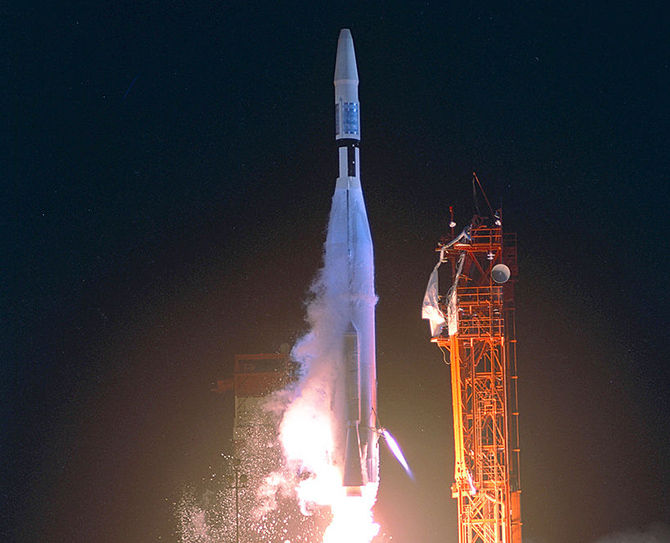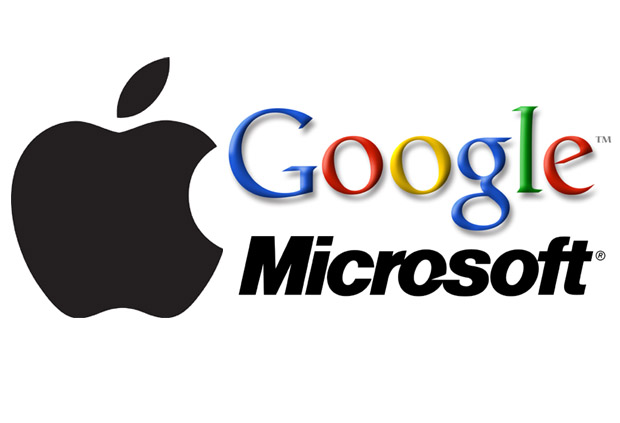The most expensive and momentous mistakes in the IT industry

Pesky bugs in software can cost companies very expensively and even endanger the existence of their business. However, the mistakes made by the “business” itself affect the fate of the IT industry and the fate of entire generations.
The first bug was fixed on September 9, 1945: a moth was found in a Mark II Aiken Relay Calculator computer that was stuck between the contacts of an electromechanical relay, which led to errors. The extracted insect was pasted into a technical diary with the accompanying inscription: "First actual case of bug being found." This funny fact marked the beginning of the use of the word "bug" in the modern sense.
')
Missile "Mariner-1": damage of 18.5 million dollars
On July 21, 1962, the Atlas launch vehicle was launched from Cape Canaveral, carrying the Mariner-1 vehicle, which was to be sent to Venus. A few minutes after takeoff, the missile deviated from the course and was undermined for security reasons.

Photo: NASA
“The engineers who analyzed the telemetry recordings soon discovered that the cause was two independent errors. The reference antenna at the Atlas was manufactured poorly, with the parameters below stated. When the signal received by the rocket became weak and noisy, the rocket lost its attachment to the signal from Earth, through which the rotation commands were transmitted. Such an opportunity was provided; in case of loss of the radio knowledge signal, the onboard computer should have ignored the signals from the faulty antenna and carried out its own program, which could possibly ensure a successful launch. However, at this moment a second error manifested itself. Somehow, in the reference program, a hyphen was missed, which led to incorrect missile control - leaving to the left and lowering the nose. The hyphen was also omitted during previous successful Atlas launches, but this part of the program was not used because there was no radio disconnect. Thus, the first attempt by the United States to carry out an interplanetary flight failed due to a missed hyphen. ”(Oran W. Nicks, NASA, 1985)
This could not have happened if the device’s antenna had not lost contact with the suggestive system on Earth. As a result, the onboard computer took over control, the program of which contained a fatal mistake.
Stadium "Hartford Coliseum": damage of 90 million dollars
On January 18, 1978, fans miraculously escaped death at the Hertford Coliseum stadium. A few hours after they left the stadium, his steel roof collapsed into the stands.

The reason for the incident - an error in the calculations in the design of the structure. Already at that time, special software was created for building design. The programmer did not take into account such factors as sleet and wind when calculating the strength of beams supporting the roof. He proceeded only from the weight of the roof itself. As a result, one of the pillars suddenly bent under the influence of snow, this caused a chain reaction, which folded the entire structure together with other parts of the roof like dominoes.
January 15, 1990, an error in the new version of the long-distance switch firmware resulted in the failure of 114 switches
Because of this, more than 60 thousand people were left without long-distance communication for 9 hours. According to the program, the switch should reboot if it receives the corresponding signal, however, this signal was mistakenly sent each time it recovered from the failure of any switch.
It all started with the fall and reboot of the switch in New York, which caused a large-scale chain reaction, which resulted in 114 switches rebooting continuously every 6 seconds. At first, the company blamed the hackers, but later it turned out that the reason was one wrong line of code in which the signal was sent.
Pentium processor bug: $ 475 million in damage
In 1994, the professor of mathematics at Lynchburg College, Thomas Nicely, discovered a bug in the popular Pentium processor and published an article about it.
Pentium FDIV error is a bug in the floating point operations module in the original Pentium processors, which were produced by Intel in 1994. The error was expressed in the fact that when performing division over floating-point numbers using the FDIV processor command, in some cases the result could be incorrect.
According to Intel, the cause of the problem was inaccuracies in the lookup table used during the division operation.
In response to this remark, Intel stated that it was ready to replace processors at the request of users who could prove that they had suffered as a result of this error.

According to Intel's forecasts, the probability of its occurrence was so low that the vast majority of users would not even notice it. However, outraged customers demanded to replace the processors with everyone. Intel's financial losses as a result amounted to about 475 million dollars.
Ariane 5 rocket: $ 8.5 billion damage
June 4, 1996 there was an unsuccessful launch of the Ariane 5 launch vehicle, which was developed by the European Space Agency. The missile collapsed in the 39th second of the flight due to incorrect operation of the onboard software. This story is remembered as one of the most expensive computer errors.

In the flight control system of the Ariane 5 rocket, fragments of the Ariane 4 rocket software were used, in particular, inertial navigation systems. However, when transferring this system for use on a new rocket, the developers did not take into account all the features. Due to the different trajectory of the missile launch, at 30 seconds after launch, the value of the horizontal speed exceeded the limits set in the program and caused the computer to malfunction.
As a result, the rocket received a false command to reject the accelerator nozzles, and later the main engine. At the 39th second of the flight, the rocket began to collapse under the action of aerodynamic forces and self-destructed.
The software installed onboard the Ariane 5 was developed for an earlier model, the Ariane 4. The more powerful Ariane 5 engine provoked a bug that was not found in previous versions of the software.
In essence, the program attempted to write a 64-bit number into 16-bit space. An overflow occurred, as a result of which both the main and the backup computer failed (since the same programs were running on both computers).
About 8 billion dollars was spent on the development of Ariane 5. The total cost of the satellites that this rocket was to put into orbit was $ 500 million.
Mars Climate Orbiter satellite: damage of 125 million dollars
Due to a fatal error, the device was too close to the surface of Mars.
The unit flew to Mars for 9 months. On September 23, 1999, the Mars Climate Orbiter had to give a braking impulse and go to a highly elliptical orbit with a period of 14 hours, and then within two months using a series of aerodynamic maneuvers in the upper atmosphere of Mars to bring the orbit to a circular one. At the estimated time at an altitude of 193 km, the device turned on the engines for braking. After 5 minutes, the MCO scheduled went beyond Mars and no more signals were received from it. From an analysis of the data, it was assumed that the spacecraft passed over the surface of Mars at an altitude of 57 km instead of the estimated 110 km and disintegrated in the atmosphere.
The subcontractor, who worked on many engineering tasks, did not perform the simplest transformation of English units of measurement into the metric system. The dispatchers came to the conclusion that the satellite at high speed entered the Martian atmosphere, where, due to the resulting overloads, its communication systems failed.
IT business errors
Often there are questions - why in the world of information technology are some of the largest deals still unfulfilled, and the most promising products do not develop? Usually the reason is that their leaders cannot predict future developments.
But the events could have turned out so that neither Microsoft nor Apple would have appeared. In the alternative world, Yahoo would be the main search engine, not Google. The most common computer would be Xerox, the most popular social network - CompuServe. And we would listen to music through RealPod.
Apple Rescue
In the late 1990s, sales of Apple Mac computers dropped significantly. This was facilitated by cheaper competitors - Power Computing and Radius. Apple's stock price fell to $ 5. But unexpectedly, help came from Microsoft: $ 150 million in assistance. In addition, Microsoft has promised to continue developing its office suite for MacOS.
Because of this decision, Microsoft has deprived itself of certain prospects. It is quite possible, today on the market WinPhone would reign, we would download music through WinTunes. And all users would still eagerly await the release of a decent alternative to Windows.

Lost market
In the mid-1990s, even before the advent of Google, the most advanced search engine was not even Yahoo, not AltaVista, not Lycos or Hot Wired. The Open Text system, like Google today, worked as quickly as possible, accurately, covering the entire volume of information. In 1995, the managers of Open Text rightly argued that their system was able to index every word from the 5 million documents that at that time constituted the World Wide Web.
However, in 1997, Open Text developers considered the search market to be insufficiently promising and took up corporate data management systems. Well, a year later, Google appeared, which showed that they were wrong about the prospects of this market.
The situation could have been different, and Google itself could not occupy the leading position now. Most likely, the services of working with information on the Internet would be different.
CompuServe and Omitted Leadership
On September 24, 1979, CompuServe launched the first MicroNET information service, which was accessed via telephone lines. The service allowed network participants to transfer files, access news and events, exchange messages and join discussion forums. In 1980, the service was renamed CompuServe Information Service (CIS).
Of course, users of the service were attracted primarily not by the news, but by the opportunity to communicate, and the CB Simulator program that appeared in 1980, which provides real-time chat, became incredibly popular. At the beginning of 1981, the number of CIS users exceeded 10,000, and by the early 1990s, it was estimated at millions, while the service was the most popular in the United States. The company had a database of loyal customers, an abundance of information about their tastes, a useful knowledge base and the almost complete absence of any competitors in this niche.

However, the service still had a text interface and per-minute billing. This is what allowed AOL, which offered a more interesting interface solution and the possibility of unlimited communication time for a small monthly subscription fee, to press CompuServe.
The service failed to gain a foothold in the market for the simple reason that the company did not want to invest money in its advantages in order to monetize the results.
Xerox Computers
Alto from Xerox was the world's first computer with a user interface in the form of windows. It was created 10 years before the advent of personal computers running Windows and Mac, long before the MITS Altair microcomputers.
Alto came with a mouse, had the ability to connect to a local network. In addition, it was pre-installed a text editor, which worked on the principle of WYSIWYG ("get what you see").
Unfortunately for Xerox, in 1973, the personal computer market simply did not exist. The company has created several thousand of these computers, which were placed in universities in the country. But further spread of these machines did not go, and Xerox did not try to promote them.

When the company realized that they had made a serious mistake, it was too late. Work began on promoting the Xerox Star graphics workstation, but this could not change the situation: as a result, Windows and Mac OS personal computers were firmly established on the market.
Unsold facebook
In 2006, when Facebook was only two years old, the general public treated it as a narrow social network for students. At that time, Facebook registered 8 million users. While the MySpace audience exceeded 100 million.
Yahoo offered Mark Zuckerberg $ 1 billion for his brainchild. In June 2006, Zuckerberg signed a contract to sell Facebook.

However, amid a dramatic deterioration in Yahoo’s financial position, then-CEO Terry Saamel lowered the amount to $ 800 million. Zuckerberg refused to sell the company for the money. Two months later, Yahoo returned to the previous terms of the deal, but it was too late. After this, the business of this company went worse. Now it is sold to Verizon Holding. In the early 2000s, Yahoo's capitalization exceeded $ 125 billion. Now Verizon has bought the company for only $ 4.83 billion.
Strange idea
The information that Steve Jobs invented the iPod is not entirely correct. The management of Real Networks did not appreciate the idea of Tony Fadell to create a completely new type of music player. By that time, the market was already saturated with MP3 players.
But his player was thinner and smaller, and the content delivery system gave music lovers simple ways to fill their player with new music. So, in 2000, Steve Jobs agreed to collaborate with Tony Fadell. Jobs finalized the design of the player, while other Apple experts finalized the content delivery system, which received the name iTunes.
As a result, about 80% of the digital music market today belongs to Apple. Tony Fadell himself worked in the office developing iTunes until November 2008. And the company Real Networks still produces regular players. However, its revenues are no match for how much iTunes brings to Apple.
Source: https://habr.com/ru/post/307394/
All Articles